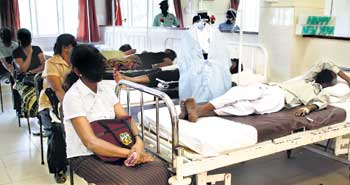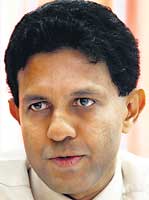
A new name, a new lookThe feeling of despair that hits you as you enter the Cancer Hospital at Maharagama is a thing of the past. Some masked faces, many bald heads…….all beautiful children. A 12-year-old, sitting up on a bed, is poring over a colourful picture book with two ducks and painstakingly pasting tiny rolled up pieces of paper on a larger duck drawn on Bristol board. A floor below, going round and round on a bicycle in a large room with brightly-coloured walls, is a small child. A couple more bicycles are parked in a corner. Welcome to the Maharagama Cancer Hospital now known as the National Cancer Institute (NCI) of Sri Lanka. Not only has the hospital undergone a name change but the feeling of hopelessness and despair that usually engulfs the area has also undergone a sea-change. More buildings, airier and brighter, replacing cramped and congested conditions, more facilities but much more than that an upbeat feeling.
"My daughter is making a duck to be displayed at the exhibition to be held on March 1," smiles the mother of the 12-year-old, explaining that she has been operated for a kakule gediyak (a tumour on her leg). Seated by the side of her daughter's bed, she whispers that she got fever and complained of excruciating pain in her right knee. "Osteosarcoma," says the mother knowledgeably. Having been in hospital for one and a half months, hopes are high in both the mother and the daughter of returning home soon, after bone-graft surgery. More than 100 children, 70% with leukaemia, take treatment here. Positive vibes emanate from all corners of this premier cancer hospital which accommodates around 850 in-ward patients at any given time. "We serve the entire nation," says Director Dr. Kanishka Karunaratne, under whose stewardship in the past one and a half years, the hospital has metamorphosised from a place considered a hell-hole to what it is today. Even at the height of the conflict patients have been brought here from the north and the east by Red Cross ambulances, stresses Dr. Karunaratne who heads this 650-bed institution which is served by 150 doctors, 300 nurses and 600 para-medical and other staff. Having worked at the hospital for 10 years as a Consultant Gynaecological Surgeon, before he took up the current post, he had set out a 10-year plan to improve it, after identifying overcrowding as one of its panaceas. "We give in-ward treatment to about 850, leaving us with about 200 floor patients," he concedes. Dr. Karunaratne, along with his dedicated staff, has opened more day treatment units for chemo and radiation therapy, catering to 150 patients daily. "These units are open seven days a week and on all holidays," he says, thus allowing those living in Colombo and its vicinity to take day treatment and return home as soon as possible. Another vital need of patients, blood transfusions, are given in a day-care unit which services about 30-40 daily, The Sunday Times learns, at the door to the unit, seeing some who have just received transfusions resting in comfortable armchairs. Understanding the inconvenience and expense that patients from the outstations face, this 45-year-old Director has set in motion plans to build a "hostel" at a cost of Rs. 175 million with funding from the CCC (Courage, Compassion and Commitment) Foundation, an Australian organization set up in Melbourne to provide assistance to the NCI. The CCC has already signed an MOU with the Health Ministry.
The hostel will provide accommodation to 250 - 100 male, 100 female and 50 child patients. "We hope to build 50 separate units within the hostel so that children can stay there very comfortably with their mothers," he says, adding that the complex will have all facilities including a TV lounge, a grocery and even a salon because patients experience hair loss during treatment. Construction work to be carried out in phases will begin in about three months. More facilities will also be developed under the Hope Project launched by the Sri Lankan Cricketers' Association which has seen the heroes who wield the willow such as Mahela Jayawardena, Sanath Jayasuriya and Muttiah Muralitharan taking it up as their cause. A major private sector company has pledged to help revive the project to put up a ward complex, which faced some difficulty when donors channelled funding to tsunami projects. "The Australian Prime Minister has met Mahela and discussed the Hope Project and the High Commission requested all the details from me last Thursday," said Dr. Karunaratne. The Director has sought assistance from the international and local Lions to establish an operating theatre complex and surgical wards while other donors have been coaxed to dig deep into their pockets and help build a three-storey extension to the present wards to get the patients off the floor and on to beds. It will see completion in May. The care and treatment of children will also be strengthened with another three-storey building, to be opened in August. This building will have a high-dependency unit to give "closed care" to very ill children, in addition to the already available Intensive Care Unit, explains Dr. Karunaratne, adding that an isolation room will also be allocated for children with cancer who contract infectious diseases.
A counselling area will be demarcated as parents who have been informed of their children's illness are traumatized and in the depths of despair. A psychologist, paid a salary by a private organization, has already been appointed to help parents cope with the fact that their child is suffering from cancer, in view of a few instances where parents have committed suicide on hearing the news, he said, adding that doctors and nurses too have undergone training in counselling to make it part of the management of all cancer patients. Especially focusing on children, the Overseas School of Colombo has established a playhouse, where a teacher also gives a few essential lessons, as children undergoing treatment have long hospital stays, missing school. The Norwegian Embassy has chipped in to buy musical instruments and the Director's vision is to have a band made up of child patients. How has all this been made possible within such a short span of time?"I opened the hospital to the public and firstly made the people in Maharagama town, then those in the country and finally internationally aware of what the needs were," he says, citing the example of the Maharagama Traders' Association taking on the task of landscaping the hospital grounds. Transparency and accountability have been very much a part of the plan. As the hospital readies to celebrate its 50th anniversary in September, the hope of Dr. Karunaratne and his staff is that they will be able to treat all patients who walk through its doors as gems or flowers. The Director's vision is to make Maharagama the best cancer hospital in Southeast Asia in a couple of years. Wish to help? Anyone who wishes to contribute towards cancer care could make donations to the following funds:
Urgent needs The hospital is in urgent need of two vital machines to make treatment much more effective, The Sunday Times understands. A Conventional Simulator to plan and identify radiation treatment, costing Rs. 60 million, is essential, says Dr. Kanishka Karunaratne, while the other machine is a High-dose Brachy Therapy Unit which targets deep-seated tumours (costing around Rs. 30 million). The C-Arm Machine which is used to target radiation to the affected area of the patient's body has been out of order for six months, The Sunday Times learns but the Portuguese Embassy has provided funding to purchase one from India. "It will be installed in about two months," assures the Director. Meanwhile, the government has provided one of the most sophisticated radiation machines with linear accelerator, valued at around Rs. 500 million, which enables spot-on radiation even for a deep-seated tumour, explains Dr. Karunaratne. The machine has been installed in an underground bunker and should be functional in about two months. |
|
||||||
|| Front
Page | News | Editorial | Columns | Sports | Plus | Financial
Times | International | Mirror | TV
Times | Funday
Times || |
| |
Reproduction of articles permitted when used without any alterations to contents and a link to the source page.
|
© Copyright
2008 | Wijeya
Newspapers Ltd.Colombo. Sri Lanka. All Rights Reserved. |


